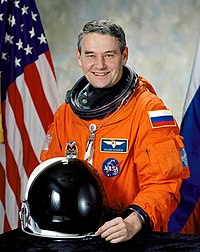Waleri Grigorjewitsch Korsun
| Waleri Korsun | |
|---|---|
 | |
| Land: | Russland |
| Organisation: | Roskosmos |
| ausgewählt am | 26. März 1987 |
| Einsätze: | 2 Raumflüge |
| Start des ersten Raumflugs: | 17. August 1996 |
| Landung des letzten Raumflugs: | 7. Dezember 2002 |
| Zeit im Weltraum: | 381d 15h 41min |
| EVA-Einsätze: | 2 |
| EVA-Gesamtdauer: | 9h 44min |
| ausgeschieden am | September 2003 |
| Raumflüge | |
| |
Waleri Grigorjewitsch Korsun (russisch Валерий Григорьевич Корзун; * 5. März 1953 in Krasny Sulin, Oblast Rostow, Russische SFSR) ist ein ehemaliger russischer Kosmonaut.
Ausbildung
Korsun schloss 1974 seine Pilotenausbildung ab und diente danach in den Luftstreitkräften als Pilot, war Kommandant eines Geschwaders und Fallschirmspringer (rund 400 Absprünge). 1987 absolvierte er die Gagarin-Luftwaffenakademie und wurde im März des gleichen Jahres in den Kosmonautenkader aufgenommen. Im Dezember begann er die anderthalbjährige Grundausbildung im „Sternenstädtchen“.
Raumfahrertätigkeit
Ab September 1989 trainierte Korsun für einen Einsatz mit verschiedenen Besatzungen zur Raumstation Mir. Vom Oktober 1992 gehörte er einer Kosmonautengruppe an, die sich für eine Rettungsmission vorbereitete. Zwischen Frühjahr 1994 und dem Sommer des folgenden Jahres bereitete er sich für einen Langzeitaufenthalt auf Mir vor.
Korsun erhielt im Oktober 1995 seinen ersten Einsatzbefehl für einen Raumflug. Er war für den erkrankten Gennadi Manakow eingesprungen und kommandierte die französisch-russische Mission „Cassiopée“, die im August 1996 mit dem Start von Sojus TM-24 begann. Während die Französin Claudie André-Deshays nach zwei Wochen zur Erde zurückkehrte, blieben Korsun und sein Bordingenieur Kaleri bis Anfang März 1997 auf der Station Mir.
Ab Januar 1999 stand Korsun der Kosmonautenabteilung im Sternenstädtchen vor. Im Juni des Jahres wurde ihm die Leitung einer Ersatzmannschaft übertragen, und er trainierte für die ISS-Expedition 3.
Danach bereitete sich Korsun als Kommandant der ISS-Expedition 5 für seinen zweiten Flug vor. Die Mission begann Anfang Juni 2002 an Bord der US-Raumfähre Endeavour mit STS-111. Zusammen mit der Amerikanerin Whitson und seinem russischen Kollegen Treschew arbeitete Korsun ein halbes Jahr an Bord der Internationalen Raumstation. Anfang Dezember 2002 wurde er mit seiner Crew wieder vom Shuttle Endeavour (STS-113) abgeholt und mit zur Erde genommen.
Im September 2003 schied Korsun aus dem aktiven Kosmonautendienst aus und ist seitdem stellvertretender Leiter des Ausbildungszentrums.
Privates
Korsun und seine Frau haben einen Sohn.
Weblinks
- Kurzbiografie von Waleri Grigorjewitsch Korsun bei spacefacts.de
- Biografie von Waleri Grigorjewitsch Korsun in der Encyclopedia Astronautica (englisch)
| Personendaten | |
|---|---|
| NAME | Korsun, Waleri Grigorjewitsch |
| ALTERNATIVNAMEN | Корзун, Валерий Григорьевич |
| KURZBESCHREIBUNG | russischer Kosmonaut |
| GEBURTSDATUM | 5. März 1953 |
| GEBURTSORT | Krasny Sulin, Russische SFSR |
Auf dieser Seite verwendete Medien
The official crew patch for the Russian Soyuz TM-24 mission, which delivered the EO-22 crew to the space station Mir.
The International Space Station (ISS) Expedition Five patch depicts the Station in its completed configuration and represents the vision of mankind's first step as a permanent human presence in space. The United States and Russian flags are joined together in a Roman numeral V to represent both the nationalities of the crew and the fifth crew to live aboard the ISS. Crew members’ names are shown in the border of this patch. This increment encompasses a new phase in growth for the Station, with three Shuttle crews delivering critical components and building blocks to the ISS. To signify the participation of each crew member, the Shuttle is docked to the Station beneath a constellation of 17 stars symbolizing all those visiting and living aboard Station during this increment.
Waleri Grigorjewitsch Korsun
The STS-111 patch symbolizes the hardware, people, and partner nations that contribute to the flight. The Space Shuttle rises on the plume of the Astronaut Office symbol, carrying the Canadian Mobile Base System (MBS) for installation while docked to the International Space Station (ISS). The mission is named UF-2 for ISS Utilization Flight number two. The ISS orbit completes the Astronaut Office symbol and is colored red, white, and blue to represent the flags of the United States, Russia, France, and Costa Rica. The Earth background shows Italy, which contributes the Multi Purpose Logistics Module (MPLM) used on this flight to re-supply ISS. The ten stars in the sky represent the ten astronauts and cosmonauts on orbit during the flight, and the star at the top of the patch represents the Johnson Space Center, in the state of Texas, from which the flight is managed. The names of the STS-111 crew border the upper part of the patch, and the Expedition Five (going up) and Expedition Four (coming down) crews’ names form the bottom of the patch.




